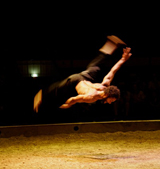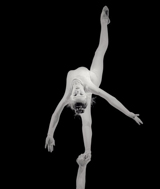by Pascal Jacob
Etymologically, an acrobat is a person who moves around on his extremities. Acrobatics is a way of playing with the body, having fun with the laws of gravity, and producing an effect of surprise to provoke admiration. Successful acrobatic movements require regular training and the physical development of the person who wishes to accomplish the act.
Learning acrobatics is linked to mastering a technical vocabulary in order to construct phrases, which are then assembled into series and sequences, accompanied by appropriate music. From Babylon to Knossos, from Rajasthan to China and from Athens to Lutetia, the objectives are the same. Throughout the centuries and the successive enrichments of an almost universal practice, an intuitive diaspora has grown up around a shared repertory.
The trajectory of acrobats mirrors that of gymnasts, but the two grow closer and merge from the 19th century, when the circus was in search of new acts and the attraction of an artistic career motivated gymnasts to take the plunge, modelling their practice into acts and acquiring costumes, thereby becoming circus artists. Moreover, from a shared trunk of figures and techniques, branches of disciplines developed, conceived with or without the support of apparatus. Whether contortion, balancing acts or hand to hand, it was essentially based on, and using, the human body, that talent bloomed. Dislocation, enabling extraordinary feats, accentuated the acrobats' fragility while extolling his capacity for recovery. Therein lies one of the secrets of the genre and the most powerful symbol of acrobatics, mastery over imbalance, a factor of progress and classical allegory of the renaissance period of transition from one state to another.
Acrobats are characterised by their strength, flexibility and agility, which are a prelude to multiple spectacular techniques that compose the fabric of a performance by gradually combining with, and enriching, equestrian exercises.
Although the banquine act, which stems from the bench jumps cherished by the saltimbancos, belongs to an etymological chain stemming from the old Italian term saltare in banco, literally, "jump on a bench," it nevertheless remains a very pure discipline in which acrobatics are performed without apparatus. It is this that makes floor acrobatics so appealing, and gives an evident dimension of simplicity to hand to hand, hand balancing acts, and Icarian games, when the latter are executed with a simple cushion attached to the lower back. Jumps are an integral part of the vocabulary of this type of acrobatics, which is sometimes described as mat work, and they help to provide it with both a dynamic and dramatic character.







